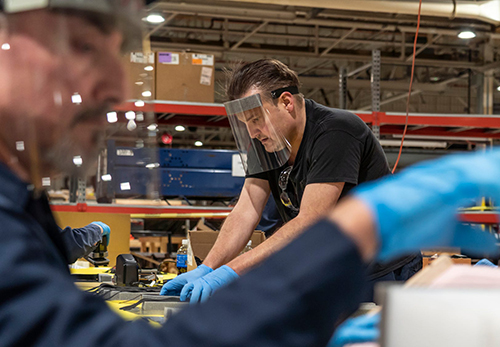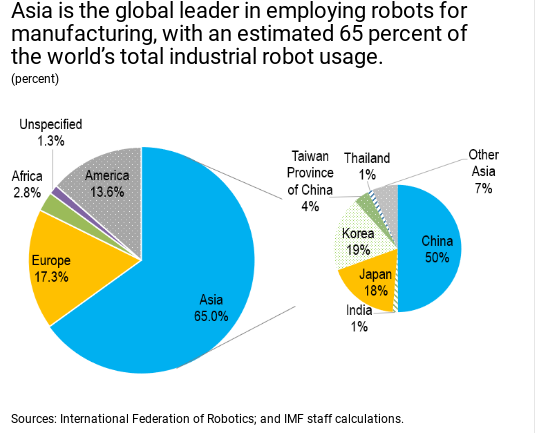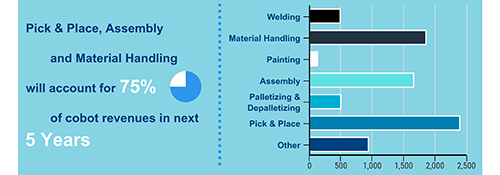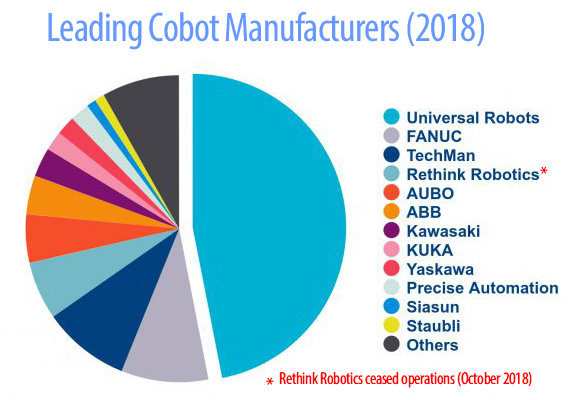
COVID Vaccine Key to Cobot & Robot Sales
Until a COVID vaccine arrives to return the natural order of things, vendors are successfully going online to reach customers. Digital, for many, may well become a permanent reality…because it works
“Unnatural” order of things
January was billed as National Cobot Awareness month. Remember that? Probably not; like most everything pre-COVID it’s kind of distantly vague these days. Like planning a family trip to DisneyWorld. What, people used to take those kinds of trips?
Getting anyone to buy a cobot, with plague in the offing, has been even more difficult. Sales have been a long, tough slog with few takers. Things took a turn for the worse with the global lockdown. Selling most anything called a robot, other than those that spray rooms with UV light or disinfect floors, became a gruesome nightmare.
KUKA broke through with the sale of 5,000 industrial robots to BMW, but that was an anomaly in an otherwise bleak spring (and was a purchase planned for months in advance). Orders for replacement parts and mobile robots have seen a little kindness, but that’s it.
With every tradeshow cancelled or postponed, with airlines grounded or flying crippled, and travel restrictions a maze of uncertainty, the normal buyer-seller communication flux has hardened into Super Glue. Such times and such uncommon events are naturally bound to throw selling anything more than a little off kilter.
Marketplace reports and research from last December predicting boffo sales of robots and cobots in the coming New Year (see below) have now recanted their heady predictions. Sales over the remainder of 2020 will be marginal at best.
Outreach for communicating with existing customers and new prospects has gone online. The best that cobot and robot vendors can do during COVID is to educate about automation and to plug the brand to everyone and anyone within earshot…and eyeshot!
Cancelled tradeshows and conferences have also gone online, funneling pieces of their former physical presence through the global digital pipeline. Showing up online as webinars and videos, some even as day-long online events or multi-day events—produced by either tradeshow/event companies or from vendors themselves—have seen encouraging numbers of viewers. But, going online in a big way is new to many, especially vendors. Some seem to be adapting quite well while others flounder.
As Bernard Marr put in a Forbes piece: “If it’s standard in your industry to go out and meet new customers face-to-face before you do business, adapting may mean opening new channels over web or social media platforms where introductions can be made and relationships fostered.”
Indeed, adaptation to digital seems to have taken hold a bit. Scott Jones, CEO of 123 Internet Group, reported: “We have seen a real spike during the last few weeks from companies wishing to create or update websites, launch new e-commerce channels and create social media campaigns focused on home-workers and a real focus on using influencers and SEO to reach new audiences.”
Top-of-mind awareness will be key when the real selling starts anew; and with it, a new digital strategy, born from COVID’s restrictions, will be in place to enhance the live events. And depending on how COVID does or does not ebb away forever, tradeshows/events may be in line for semi-permanent transformations like permanent social distancing. Yikes!

A broad digital strategy may well turn out to be the key to future success.
David Naumann from enVista agrees: “As more event companies and vendors ‘perfect’ virtual meetings, in some cases they will replace or augment some in-person events.”
Vaccine hero
Of course, normalcy won’t return until a viable COVID vaccine shows itself, which could be as early as November, after almost a full year of plague.
As a TechXplore article, The Coronavirus Could Mark the Rise of Automation put it: “COVID-19 has left us wondering about the future of work and with this, the capacity of automation to step in where humans must step back.”
Sure, automation is figuring into the thinking of many, but six feet apart and a Plexiglas wall between people standing on expensive floorspace in any modern factory won’t last too long. Commonsense alone is screaming out how ridiculously impractical it all is; and expensive! Such walled-off worker zoning will break the bank of most any SME (the primary buying targets for cobot sales).
Does anyone really think that Factory 4.0 is going to succeed with social distancing, face masks, and a trip to a ventilator if an errant sneeze droplet takes out a worker?
We’ve spent the last two millennia convincing ourselves that togetherness and closeness were virtuous activities and made anything possible, and the last four months demanding that we shun each other’s embrace.
Seems only a COVID vaccine can bring back that natural relationship.
ABI Research is gloomy, but probably correct, saying succinctly: “COVID-19 represents a disaster for robotics vendors building solutions for developed markets in manufacturing, industry, and the supply chain.”
In fact, ABI is out with a commonsense, well-reasoned, and well-documented take at what’s going and on and where things may go: TAKING STOCK OF COVID-19: The Short- and Long-Term Ramifications on Technology and End Markets. ABI’s chapter on INDUSTRIAL, COLLABORATIVE & COMMERCIAL ROBOTICS: Time to Reassess the Global Manufacturing Supply Chain, begins on p.17.
The realization upon reading it: Robot and cobot sales won’t really begin until a COVID vaccine, one that’s majorly efficacious, has arrived on the scene and a gazillion people have had a shot.
Until then, COVID has forced the birth of a new way for vendors to communicate with customers that is showing promise, and may well end up as a permanent part of any promotional strategy.
With a COVID Vaccine, Forecasts Will Revert to This: Happy Days Here Again!
Global Industrial Robot & Cobot Market 2021-2025
 Asia-Pacific Industrial Robot Market
Asia-Pacific Industrial Robot Market
Forecast for the fastest growing geographic segment: Asia-Pacific; largest market: Asia-Pacific; CAGR 12.5 percent.
Markets and Markets reports that Asia-Pacific held the largest share in 2018, but lost share in industrial robots when countries like “China due to the falling demand from the automotive sector and the effects of the US-China trade war” experienced a slowdown. However, even given a slowdown in sales, Asia-Pacific was still the largest market in 2018 at $19.8 billion (including peripherals, software, and system engineering).
Major industrial robot manufacturers posted a lower than expected growth and revenue for the year ending 2018. Asia-Pacific is expected to still retain the largest share during the forecast period through 2024.

“Asia-Pacific is forecast to control the robotics market during the forecast period [2020-2024] due to advancements in camera and sensor technologies in the region.”
Software Asia 2021-2026 (largest regional market in the world): Cumulatively, over the next six years (2021-2026), the Asia-Pacific software market for industrial robots is forecast to bulk up by nearly $100 billion ($92.23 billion), reports Yahoo Finance.
The annual shipment in this region will advance to 1.11 million units in 2026 with a 2019-2026 CAGR of 17.89%.
Asia-Pacific Cobot Market 2021-2026
Asia-Pacific collaborative robot market will grow during 2021-2026 at a CAGR of 45.46 percent, with an addressable cumulative market value of $13.17 billion over the next 7 years in terms of cobot hardware. This region is expected to become the largest cobot market worldwide during the forecast period.
With only 14,000 cobots sold globally in 2019 (barely 4 percent of global output), this emerging market is expected to witness an exponential growth in cobots over the forecast period (2021-2026). With advantages of increasing flexibility, improving production efficiency and reducing operational cost, industrial cobots have been deployed to assist human workforce and to keep manufacturers competitive in the global markets.

See related for Cobot Sales Leaders & Changing Application Mix (2018-2027):
Cobots as Force Multipliers
Is Disruption Ahead for the Cobot Revolution?
Does the cobot revolution need the revolution of e-commerce to drive wide-scale adoption?

The reasons for cobot popularity among SMEs are easy to understand. According to the Danish Technological Institute (DTI), there are five: Price, safety, flexibility, ease of use, and increased productivity. And, of course, the all-important return on investment (ROI).
The near-term sales figures for cobots (between 2019 and 2020) were heady but only a fraction of total sales of industrial robots; the numbers beyond for 2021 through 2025 are forecast to be nothing short of mind-boggling.


